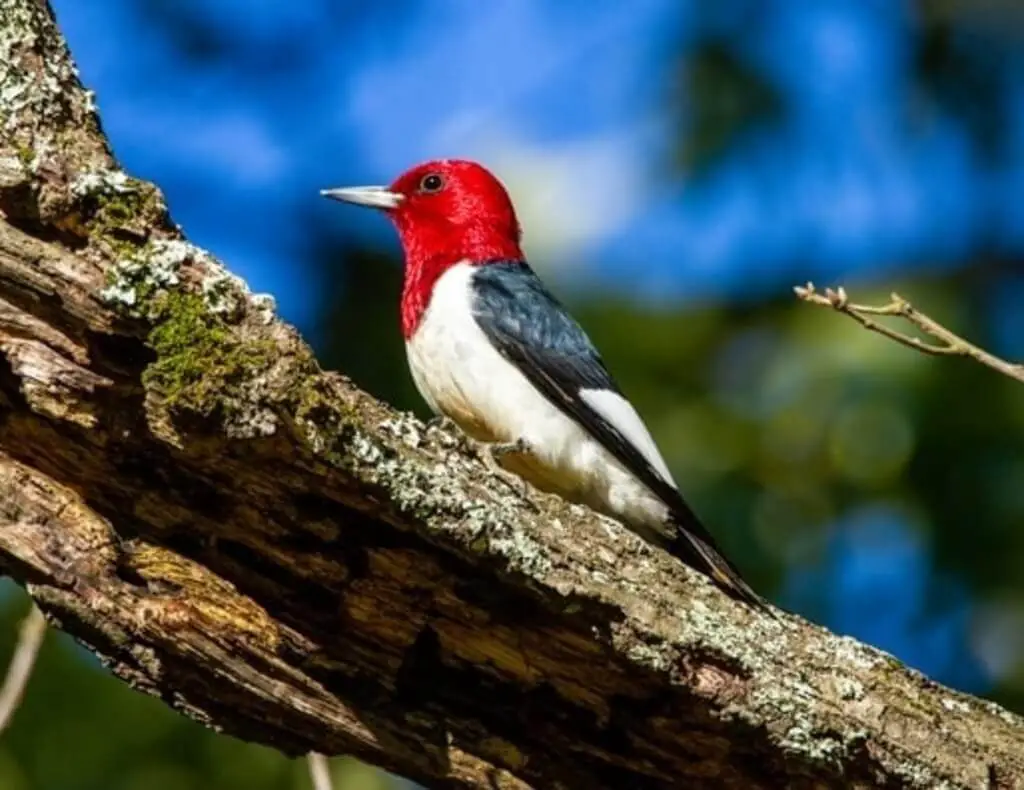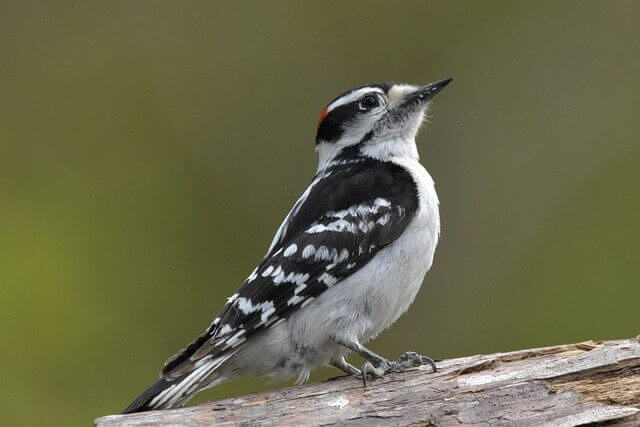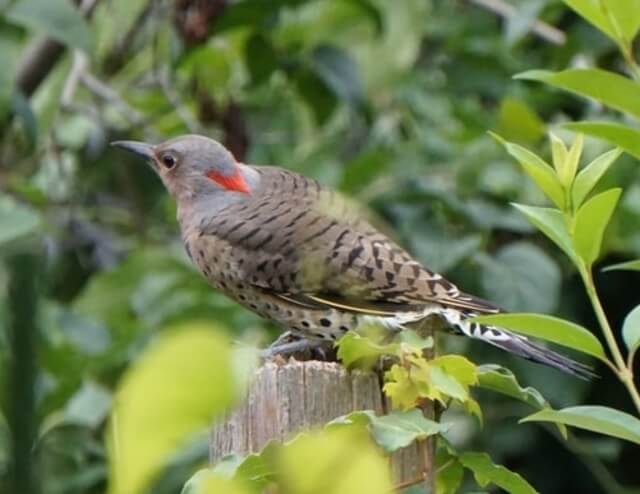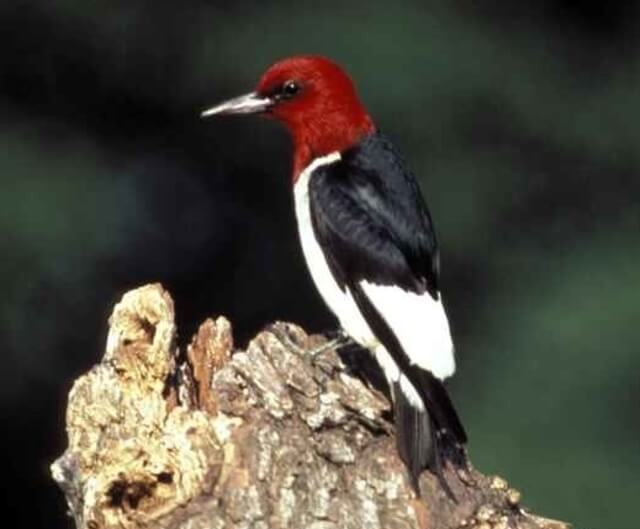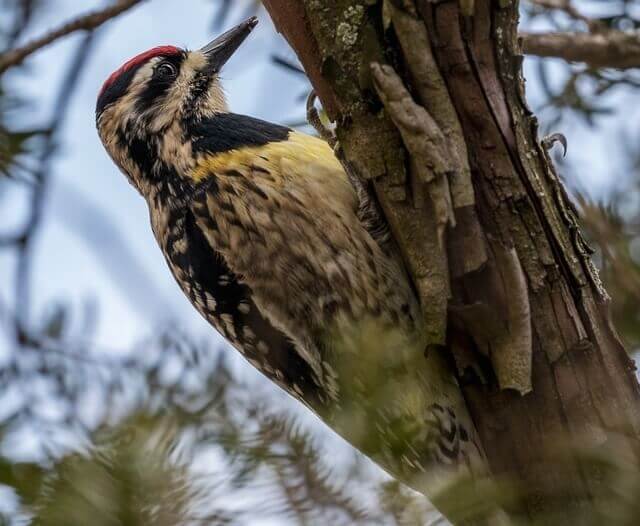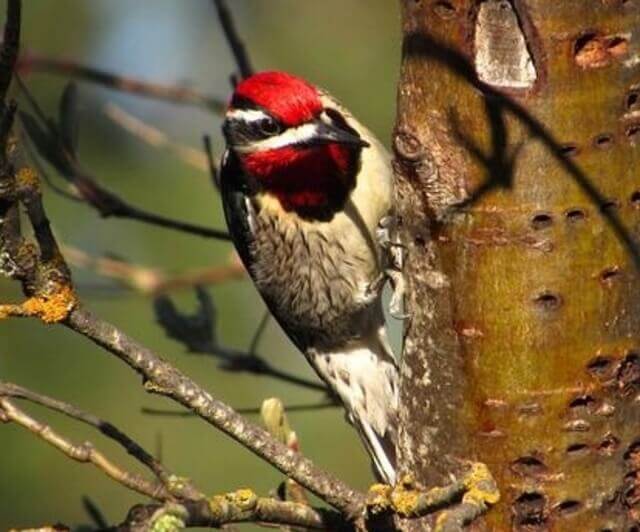Step into the captivating world of Woodpeckers in Ohio! Immerse yourself in the enchanting beauty of 10 distinct species as we unveil stunning photos and share intriguing facts about these fascinating birds that gracefully inhabit the woodlands of Ohio. Join us on this exploration into the diverse tapestry of Ohio’s avian wonders!
Table of Contents
Types of Woodpeckers in Ohio
Red-bellied Woodpecker
- Length: 9.4 in (24 cm)
- Weight: 2.0-3.2 oz (56-91 g)
- Wingspan: 13.0-16.5 in (33-42 cm)
- Frequency of Occurrence: 37.60% (Statistic by: eBird)
- Where To Find Them: In Ohio, they can be found in counties near the Ohio River and in the southeastern corner of the state. The best place to see them is at Hocking Hills State Park where they can be seen year-round. Other good spots to see them include Caesar Creek State Park, Shawnee State Forest, and Malabar Farm State Park.
- How to Attract: You can provide food for red-bellied woodpeckers by putting out a mix of sunflower seeds, peanuts, and suet. These birds also love to eat insects, so you can also put out a bowl of water with some rocks in it so the insects can drink. Red-bellied woodpeckers will also appreciate having a place to perch, so you can provide them with a dead tree or a large branch that has been left in your yard. You can also put up a birdhouse for these birds to use.
The Red-bellied Woodpecker is a medium-sized woodpecker found in the eastern half of North America. They are usually found in deciduous forests and woodlands, but can also be found in parks and suburbs. These birds eat insects, nuts, fruits, and seeds.
They forage on tree trunks and branches, sometimes hanging upside down to do so. Red-bellied woodpeckers breed from central Canada south to Florida and Texas. They build their nests in tree cavities, often using abandoned nests of other birds.
Downy Woodpecker
- Length: 5.5-6.7 in (14-17 cm)
- Weight: 0.7-1.0 oz (21-28 g)
- Wingspan: 9.8-11.8 in (25-30 cm)
- Frequency of Occurrence: 37.57%
- Where To Find Them: Some good spots to see downy woodpeckers in Ohio include Hocking Hills State Park, the Cuyahoga Valley National Park, the Columbus Zoo and Aquarium, and the Cleveland Metroparks Zoo.
- How to Attract: Downy woodpeckers are attracted to areas with large trees, dead trees, and open areas with plenty of insects. They can be attracted to your backyard by putting out a feeder with suet or peanut butter, and leaving a few dead trees or branches for them to perch on.
The Downy Woodpecker is the smallest woodpecker in North America, measuring only 5 – 7″ inches in length. They are found in deciduous and mixed forests, as well as urban and suburban areas. Downy Woodpeckers feed on insects, as well as fruit and sap from trees.
They can be seen perched on tree trunks or branches, where they use their strong bills to peck at bark and insects. Downy Woodpeckers are common throughout most of their range, and are considered a species of the least concern by the IUCN.
Northern Flicker
- Length: 11.0-12.2 in (28-31 cm)
- Weight: 3.9-5.6 oz (110-160 g)
- Wingspan: 16.5-20.1 in (42-51 cm)
- Frequency of Occurrence: 20.13%
- Where To Find Them: Northern Flickers can be found in many different parts of Ohio. Some spots where they can be commonly seen are in the Cuyahoga Valley National Park, Hocking Hills State Park, and the Wayne National Forest. They can also be spotted in other areas such as the Columbus Zoo and Aquarium, Summit Metro Parks, and Prairie Oaks Metro Park.
- How to Attract: One of the best ways to bring them in is by putting out a feeder that has sunflower seeds. Northern Flickers also enjoy eating insects, so supplying a shallow water dish will give them another opportunity to dine. Placing a log or stump in the yard will give the birds a place to perch and survey their surroundings.
The Northern Flicker is a medium-sized woodpecker that can be found in various habitats across North America. They range from the Pacific Northwest to the eastern seaboard, and as far south as Mexico. Northern Flickers prefer open areas with large trees, but can also be found in forests, parks, and even suburban neighborhoods.
These woodpeckers feed on a variety of foods, including insects, fruit, seeds, and nuts. They often forage on the ground or in trees, and sometimes cling to vertical surfaces like bark or tree trunks. Northern Flickers are known for their characteristic “flickering” flight pattern – they will fly up to a high perch and then swoop down to the ground in quick succession.
Hairy Woodpecker
- Length: 7.1-10.2 in (18-26 cm)
- Weight: 1.4-3.4 oz (40-95 g)
- Wingspan: 13.0-16.1 in (33-41 cm)
- Frequency of Occurrence: 10.59%
- Where To Find Them: Some good spots to find them in Ohio include Zaleski State Forest, Shawnee State Forest, Hueston Woods State Park, and Great Miami Wildlife Refuge.
- How to Attract: If you want to attract these birds to your backyard, there are a few things you can do. One thing you can do is provide a food source for them. Hairy Woodpeckers like to eat insects, so providing a feeder that has a variety of insects will attract them. You can also put up a nest box for them to use. Hairy Woodpeckers prefer dead trees or snags for nesting, but they will use nest boxes if they are available. Finally, make sure your yard has plenty of trees and shrubs for the birds to perch on.
The Hairy Woodpecker is a small black and white bird. The territory it covers stretches from southern Canada to northern Mexico, and across the Atlantic coast to the Great Basin.
The Hairy Woodpecker inhabits a variety of habitats, including open woodlands, mixed woods, parks, and suburban areas. It feeds on insects and other invertebrates, which it extracts from trees by drilling into the bark with its stout bill.
Pileated Woodpecker
- Length: 15.8-19.3 in (40-49 cm)
- Weight: 8.8-12.3 oz (250-350 g)
- Wingspan: 26.0-29.5 in (66-75 cm)
- Frequency of Occurrence: 7.95%
- Where To Find Them: In Ohio, you can find pileated woodpeckers in the Appalachian foothills, the Allegheny Plateau, and the glaciated regions of the northeast.
- How to Attract: In order to attract these birds, you will need to provide them with a food source that they like. Suet cakes, peanuts, and sunflower seeds are all great options. You can also place a few dead trees or logs in your yard to give the birds a place to roost and nest. If you live in an area where pileated woodpeckers are common, be sure to put up a bird feeding station so you can enjoy watching these beautiful birds up close.
The Pileated Woodpecker is the largest woodpecker native to North America is . It ranges from southern Canada to northern Mexico and is found in deciduous and mixed forests. These birds prefer areas with large trees, where they can find plenty of food.
Pileated woodpeckers eat insects, mostly ants and beetles, as well as fruit and nuts. They sometimes drill into trees to get at insect larvae or sap. These woodpeckers are important for controlling insect populations.
Red-headed Woodpecker
- Length: 7.5-9.1 in (19-23 cm)
- Weight: 2.0-3.2 oz (56-91 g)
- Wingspan: 16.5 in (42 cm)
- Frequency of Occurrence: 5.23%
- Where To Find Them: In Ohio, they can be found in the eastern and southeastern parts of the state. Some places to find them include Hocking Hills State Park, Dawes Arboretum, and Malabar Farm State Park.
- How to Attract: You can attract red-headed woodpeckers to your yard by providing a food source and a nesting site.The best way to provide a food source is to install a bird feeder. Red-headed woodpeckers will eat black oil sunflower seeds, peanuts, and suet. Be sure to keep your bird feeder clean and filled with fresh seed.A good way to attract red-headed woodpeckers to your yard is to provide them with a nesting site. You can do this by installing a nest box or by creating a dead tree snag. The nest box should be placed in an open area near a large tree.
The Red-headed Woodpecker is a medium-sized woodpecker that is found in open woodlands, parks, and residential areas across much of North America. These birds prefer to live in deciduous forests, but they can also be found in coniferous forests and even urban areas.
Red-headed woodpeckers are omnivorous and eat a variety of foods, including insects, fruit, nuts, and seeds. They forage on trees and utility poles, often hammering on surfaces to find food. These birds are known for their loud calls, which can be heard throughout their range.
Yellow-bellied Sapsucker
- Length: 7.1-8.7 in (18-22 cm)
- Weight: 1.5-1.9 oz (43-55 g)
- Wingspan: 13.4-15.8 in (34-40 cm)
- Frequency of Occurrence: 2.11%
- Where To Find Them: The Yellow-bellied Sapsucker is a migratory bird that can be found in certain spots in Ohio during the late winter and early spring. Some of these spots include the Hocking Hills, the Cuyahoga Valley National Park, and the Pymatuning Reservoir.
- How to Attract: One of the easiest ways to attract a yellow-bellied sapsucker is by putting up a suet feeder. Sapsuckers are attracted to the high-fat content of the suet. You can also put out a platform feeder with seeds and nuts that will attract these birds. If you have a fruit tree in your yard, the sapsuckers will likely visit it to eat the ripe fruit. Finally, make sure you have a water source available for the birds, as they will drink from it as well.
The Yellow-bellied Sapsucker is a medium-sized woodpecker. It is the only woodpecker in North America with a yellow belly. The yellow-bellied sapsucker is found in Canada, the United States, and Mexico. Its range extends from Alaska to Florida, and from California to Texas. They inhabit forests and woodlands, and can be found in both deciduous and coniferous forests.
The diet of the yellow-bellied sapsucker consists mostly of sap from trees, but it also eats insects, fruit, and seeds. It drills into trees to extract sap, using its sharp beak and tongue. It also uses its long tongue to capture insects on the surface of branches or leaves. These birds are cavity nesters, and will excavate their own nests in trees or use abandoned nests of other birds.
Red-naped Sapsucker
- Length: 7.9-8.7 in (20-22 cm)
- Weight: 1.9-2.2 oz (53.1-63.5 g)
- Wingspan: 14.6-16.0 in (37-40.6 cm)
- Frequency of Occurrence: 0.0001%
- Where To Find Them: In Ohio, they can be found in the northeast region near the Pennsylvania border and in the southwest region near the Kentucky border.
- How to Attract: You can attract them to your yard by providing a food source and nesting area.
The best way to provide a food source for the Red-naped Sapsucker is to install a bird feeder. They will eat a variety of seeds, so make sure to offer a mix of sunflower seeds, thistle seeds, and millet. You can also place suet cages in your yard to attract these woodpeckers. To provide a nesting area for the Red-naped Sapsucker, you can install a nest box. The box should be placed in an open area near large trees.
The Red-naped Sapsucker is a medium-sized woodpecker found in North America. They are most commonly found in coniferous forests, but can also be found in mixed woods and deciduous forests.
They range from southern Alaska to central Mexico. Red-naped sapsuckers use their specially adapted bills to drill sap wells in trees. They eat insects and larvae that they find while feeding on the sap, as well as fruit and nuts.
Black-backed Woodpecker
- Length: 9.1 in (23 cm)
- Weight: 2.1-3.1 oz (61-88 g)
- Wingspan: 15.8-16.5 in (40-42 cm)
- Frequency of Occurrence: 0.0001%
- Where To Find Them: Black-backed woodpeckers are typically found in mature forests across the state of Ohio. They can be seen in various areas such as the Cuyahoga Valley National Park, Shawnee State Forest, and Hocking Hills State Park.
- How to Attract: These birds like to live near large trees and can be attracted to your backyard by putting up a feeder with suet or kernel corn. Black-backed woodpeckers are also attracted to dead trees, so if you have a dead tree in your yard, leave it alone and see if the woodpeckers move in.
The Black-backed Woodpecker is a North American bird that ranges from Alaska to northern Mexico. They live in coniferous and mixed forests, as well as open woodlands. These birds are omnivorous and eat insects, sap, fruit, nuts, and carrion.
Black-backed woodpeckers have strong bills and tongues, which they use to extract insects from trees or crevices. They also have stiff tail feathers which they use as props while climbing trees.
Red-cockaded Woodpecker
- Length: 7.9-9.1 in (20-23 cm)
- Weight: 1.5-1.8 oz (42-52 g)
- Wingspan: 14.2 in (36 cm)
- Frequency of Occurrence: 0.0001%
- Where To Find Them: There are three primary areas where they reside: the Shawnee Hills, the Hocking Hills, and the Allegheny Plateau. The birds prefer to live in mature pine forests, and can often be found near water sources. They are typically shy and difficult to spot, but keen birders may have a chance to see them during the spring or fall migration periods.
- How to Attract: One way to create the right habitat for Red-cockaded woodpeckers is by planting pine trees. You can also provide a source of food for these birds by putting out suet or bird feeders that offer peanuts, sunflower seeds, or other small nuts. Keep in mind that Red-cockaded woodpeckers like to drill into tree trunks, so you may also want to install a few wooden bird houses in your yard.
The Red-cockaded Woodpecker is a federally endangered species that can be found in the southeastern United States. The bird’s range extends from eastern Texas to the Atlantic coast, and as far north as Virginia.
The Red-cockaded woodpecker prefers mature pine forests for its habitat, and can be found in both public and private land. These birds feed primarily on insects, although they will also eat acorns, nuts, and berries.

